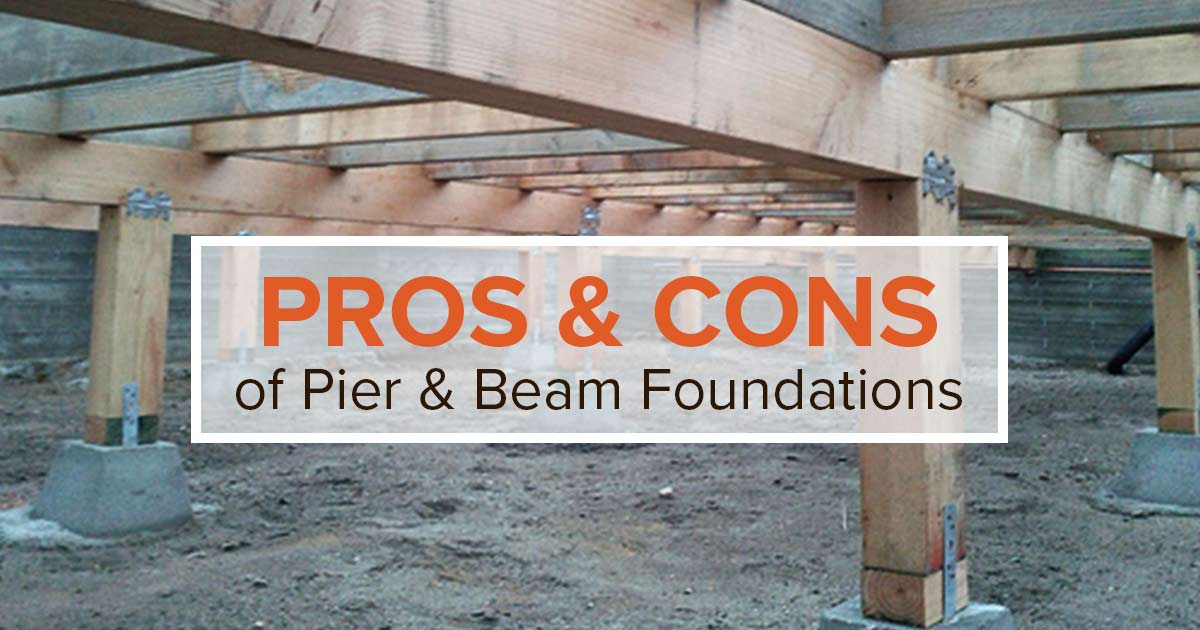512.291.0709
Mon - Fri: 9 AM - 11:30 AM
12:30 PM - 4 PM
June 13, 2022

Pier and beam foundations are a common sight in Austin, Texas. While they provide many benefits for our type of terrain, they also have some weaknesses that homeowners should be aware of. Let’s review the basics of this foundation type and assess the pros and cons.
Pier and beam foundations are different from slab foundations in that they rely on a grid of columns (“piers”) to act as the support structure for the home. Each pier is driven deep into the ground for stability. At the top of the pier is where a wood beam rests, providing the horizontal plane of support. There are different pier types available, including concrete, steel, and helical.
The majority of the Austin region is built on the Blackland Prairies, which consist of clay soils that easily shrink and swell in response to moisture patterns. Another part, the Post Oak Savannah Floodplains, features loose, sandy soil that is apt to shift or wash away in the face of the area’s regular floods.
As such, most Austin homes face some serious stability challenges. The penetrative structure of pier and beam foundations allows for support to be maintained even when the soil surrounding the piers moves. Because pier systems are driven down into the bedrock whenever possible, they have a source of stability that remains constant, even when the upper soil is dynamic.
The raised structure of pier and beam systems creates ample space between the bottom of the home and the ground below. This crawlspace acts as a buffer zone in the event of flooding.
Where slab-bottomed houses are at risk of flooding with just a few inches of water, pier and beam homes can stay safe and dry through all but the strongest deluges.
That extra space beneath the home is also very useful for housing installations such as piping and wiring. This provides much greater accessibility than you’d get with slab foundations, where these structures must be routed right through the concrete.
Another benefit of the accessible space is that it’s easy to find and repair damaged portions of the foundation. There’s often more than enough room for foundation experts to go right into the crawlspace and perform the necessary work, without damaging any other part of your home.
Because houses rest on top of the raised pier and beam structure, it’s easier to lift the home and transport it to another lot. It’s a rarely used option, but is sometimes used by homeowners who want to relocate out of Austin’s floodplain without giving up their much-loved home.
Traditional concrete pier systems are at risk of succumbing to the weight of your home. This is because standard installation practices use a rectangular jacking block, which doesn’t equally distribute the weight of the top cap cylinders. Extra stress is put on the jacking block – the weakest point in the structure – eventually leading to cracking or tilting.
This problem is avoidable, however. Douglas Foundation Repair has developed a proprietary jacking block configuration that eliminates extra strain, properly distributing the weight down into the concrete pier. Our solution achieves a 40% increase in support and wards off the need for future repairs.
Slab foundations became more popular when the demand for quick and affordable housing construction rose. Pier and beam systems require more work to build, and their more advanced materials also contribute to a higher price tag.
Despite the extra expense, pier and beam foundations can still be fairly affordable, especially when you consider the saved costs of eventually repairing a weaker slab foundation.
Cool, quiet, and dark crawlspaces make the perfect hiding spots for local critters. Raccoons, opossums, and even rats have all been known to make crawlspaces their homes. The extra humidity found in these areas also makes them a prime habitat for insects.
Infestations can be avoided with regular spraying and inspections. Larger animals can be repelled by installing screens that keep the vent openings from becoming entry points.
Without a solid plane of supportive material beneath the bottom of the home, floorboards can move more under the weight of foot traffic. You can end up with creaky floorboards after some time.
You can target the squeaky spots by installing shims between the nearest supports (floor joists) below. This can go a long way toward reducing the noise.
The open crawlspace and shifting soil associated with pier and beam foundations creates conditions where water is more likely to pool. If this water stands for too long, it can cause excess humidity, attract pests, and even foster mildew growth.
It’s advised to install dedicated drainage points in your crawlspace, even if you have yet to see signs of ponding. This will ensure the area stays dry and prevent extra soil movement.
Because air can move freely into the crawlspace, it’s common for the floors of pier and beam homes to feel colder than their slab counterparts. This is why it’s especially important to ensure that the flooring contractors don’t skip on installing subflooring, which will act as an insulating layer.
Selecting the right foundation for your home requires expert insight. The team at Douglas Foundation Repair is happy to help you assess your property and advise the best choice. Whether that’s a pier and beam foundation or another type, our specialists will ensure you’re set up with the installation that offers the best balance of value and performance.
If you already have a pier and beam foundation that is in need of some TLC, we also perform repairs. We’ll help you resolve any problems you’re experiencing and get your foundation back into shape. Contact us to schedule your inspection.